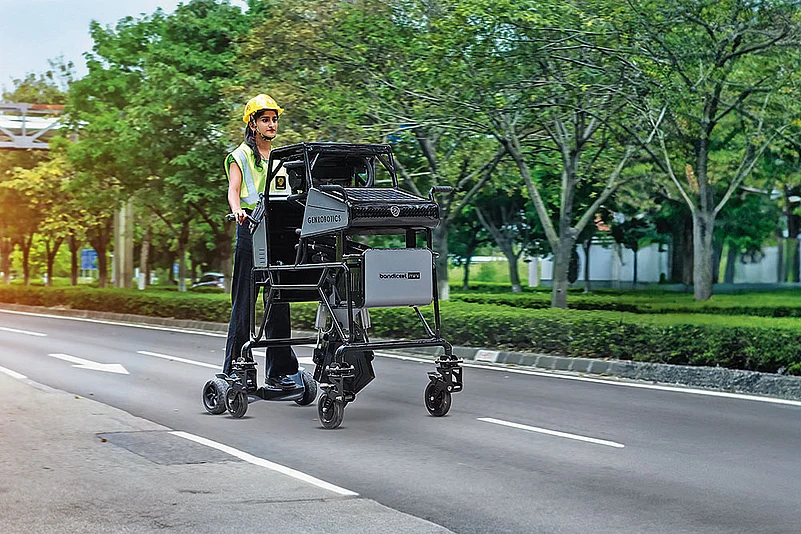Last month 43-year-old Panth Lal Chander died while another worker was admitted to a hospital in critical condition after they went into a manhole while working for Delhi Jal Board. The accident happened in southeast Delhi’s tony New Friends Colony neighbourhood.
A similar accident had propelled a group of friends in an engineering college in Kerala to look for solutions to the problem of manual scavenging.
Vimal Govind MK, Arun George, Rashid K and Nikhil NP were students at MES College of Engineering, Kuttipuram when they first encountered the harsh realities of manually cleaning sewers. The loss of three lives—two sanitation workers and an auto driver who attempted to rescue them—due to toxic fumes in a manhole, exposed the grim conditions that persisted despite strict legal prohibitions.
Birth of Bandicoot
In 2017 the quartet founded Genrobotics Innovations in Thiruvananthapuram and in 2018 launched their groundbreaking innovation—Bandicoot, the world's first robotic scavenger.
“The problem was not just about creating a product; it was about integrating it into a larger system. We had to build the infrastructure for its adoption, including training, support services and scalable production,” says Govind. By 2018, Bandicoot was deployed in Kerala, marking the beginning of its nationwide rollout.

Today Bandicoot is being used in 19 states and three Union Territories with over 300 robots scavenging. Municipalities that have adopted the technology are expanding their fleets, reinforcing policy changes that support mechanised sanitation.
The robot, designed to enter and clean manholes, mimics human movement using robotic arms and legs. Equipped with cameras and specialised tools, it allows operators to control the cleaning process from above ground, doing away with the need for humans to enter manholes.
Genrobotics’ vision and early-stage innovation also caught the attention of investors. Anil Joshi, managing partner at venture-capital firm Unicorn India Ventures, recalls, “We invested in Genrobotics at seed level when they were working on the first prototype. We were impressed with the vision of the founders to help build robotic solutions to safeguard humans from hazardous environments. When we evaluated the space, we realised no one was working on this, and the market was quite big enough for us to support the company.”
Beyond Bandicoot
Beyond sanitation, Genrobotics is also pioneering exoskeleton technology aimed at industrial and health-care applications. “We realised that our expertise in robotics could be extended to help people with mobility challenges and assist workers in physically demanding jobs,” says Govind.
Their exoskeleton suits, designed to enhance human strength and endurance, are being developed for sectors like manufacturing and rehabilitation. By integrating AI-driven motion control, these robotic systems aim to reduce workplace injuries and improve quality of life for individuals with movement impairments.
Recognising similar challenges beyond India, the company has begun exporting Bandicoot to Malaysia and is actively exploring markets in Southeast Asia, the UAE and Africa. “Many developing nations face sanitation challenges similar to India’s. Our goal is to create global impact by leveraging robotics and AI to eliminate hazardous manual labour,” Govind says.
Bandicoot mimics human movement... Equipped with cameras and tools, it allows operators to control the cleaning process from above the ground
Genrobotics’ expansion has been fuelled by strong investor backing. The company raised Rs 20 crore from tech company Zoho and secured funding from marquee investors, including Unicorn India Ventures. The company has used a mix of investments, loans and government support to scale manufacturing and research efforts.
On the revenue front, Genrobotics has grown steadily over the years. The company posted revenue of Rs 20 crore last year, up from Rs 14 crores in the previous year and Rs 12 crores before that. Despite a slight negative balance last year due to increased R&D spending and the impact of elections on government orders, they have maintained an average profitability margin of 20% over the years, with some periods even touching 45%.
Doubling Down on R&D
R&D remains a primary focus for Genrobotics. “Most of our revenue is reinvested into R&D, and even our funding rounds are directed towards innovation,” says Govind. Over the years, the company has invested nearly Rs 70 crore into R&D. This continuous research effort is helping them push the boundaries of robotic applications in sanitation, medical technology, and industrial automation.
The company is now expanding its expertise into the oil and gas sector. “Oil and gas infrastructure faces similar challenges to sanitation, particularly with pipeline maintenance and tank cleaning,” says Govind. Genrobotics has developed an innovative cleaning solution that allows tanks to be cleaned while still containing oil.
In sanitation, Genrobotics competes with traditional manufacturers of suction-jetting machines and cleaning equipment that have long been dominant in the space. However, Govind points out that most competitors use older technologies with high operational costs. “We leverage AI, robotics and automation to provide cost-effective and efficient solutions,” he says.
According to data from Ministry of Social Justice and Empowerment, 377 people died cleaning sewers and septic tanks between 2019 and 2023. If more municipal bodies replace manual scavengers with robots surely India will do away with a national shame.











